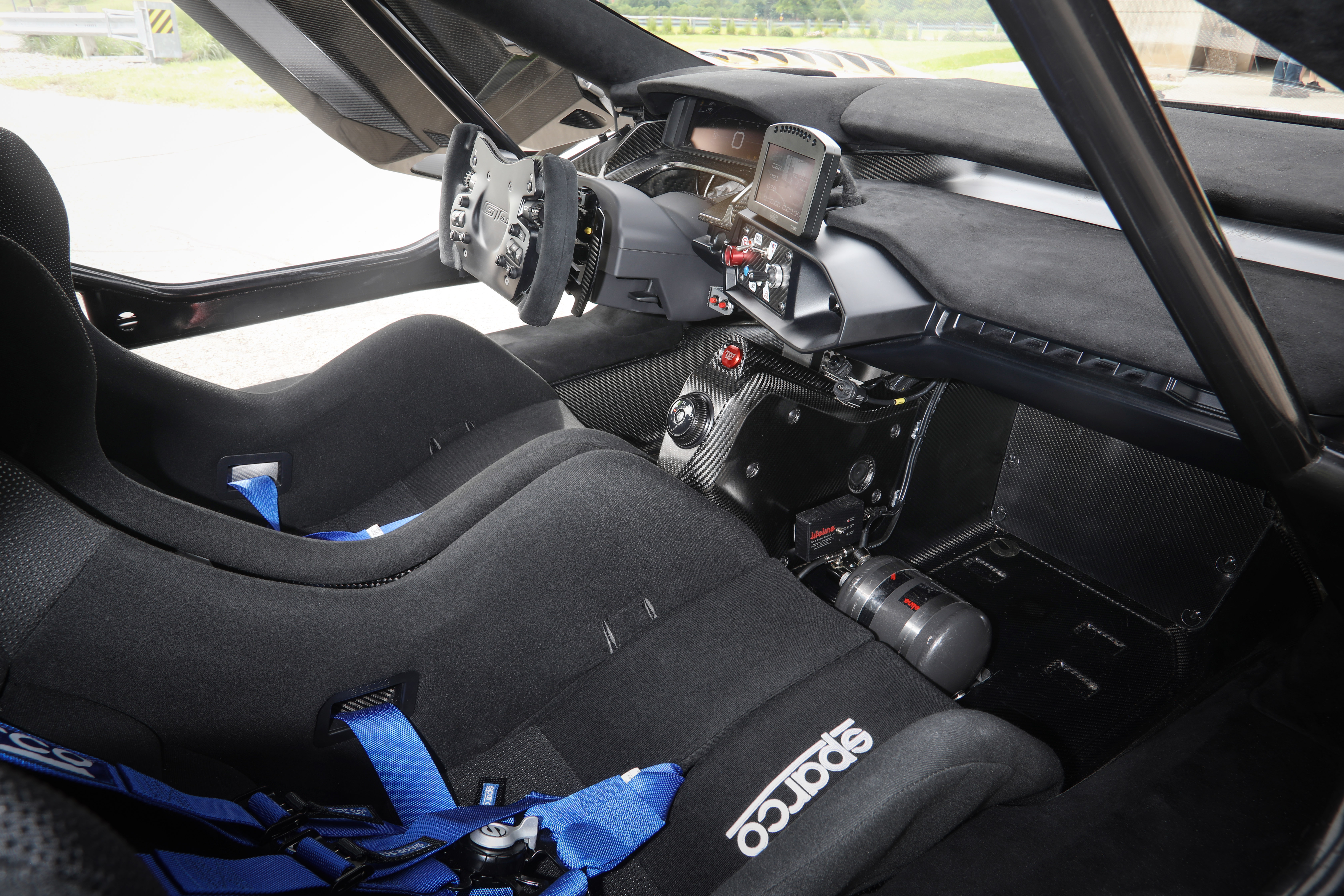Ford Performance and Multimatic, a major supplier of engineering expertise, unveiled the Ford GT Mk II, a track-only version of Ford’s latest supercar, on July 4 at the Goodwood Festival of Speed.
The limited-edition car represents the next stage in Ford GT performance, the companies said, with 700 horsepower from its 3.5-liter EcoBoost engine, and with race-proven aerodynamics and competition-oriented handling. Innovations and improvements include aerodynamic enhancements for added downforce, additional weight reducation and chassis updates for better handling.
Only 45 will be produced and will be priced at $1.2 million each.
“The GT Mk II unleashes the full performance potential of the Ford GT without any artificial performance limitations dictated by racing sanctioning bodies,” said Hau Thai-Tang, Ford chief product development and purchasing officer. “It’s the closest GT owners can get to the Le Mans-winning performance and exhilarating feeling of crossing the finish line in the Ford GT race car.”
“The true off-the-hook performance capability of the GT hasn’t yet been fully showcased,” added Multimatic’s chief technical officer Larry Holt. “The road car is obviously limited by the many global homologation requirements that it must comply with, and the race car suffers from the restriction of the dreaded Balance of Performance, resulting in it being 150 horsepower down to the road car. The Mk II answers the regularly asked question of how would the car perform with all the limitations lifted: the answer is spectacularly.”
Built in Markham, Ontario, the Mk II begins life at the main Ford GT plant before being transferred to a specialist facility at Multimatic Motorsports where it is crafted into the Ford GT Mk II.

These aggressive aerodynamic changes enable the GT Mk II to generate over 400 percent more downforce than the Ford GT while fixed aerodynamic elements along with its race-proven suspension and Michelin Pilot Sport racing tires enable the car to pull more than 2g of lateral grip.
GT Mk II is also lighter and more agile. The street car’s adjustable ride height and drive modes have been removed, providing a weight savings of over 200 pounds while 5-way adjustable DSSV shock absorbers work with a lowered and fixed ride height to improve handling and keep the Mk II as aerodynamically efficient as possible.
The Ford GT Mk II features the 3.5-liter EcoBoost engine that powers both the Ford GT race car and the road car but since the Mk II is not limited by any racing sanctioning body it is able to generate 200 horsepower more than the race car, making the Mk II the most powerful version of the Ford GT. The 3.5-liter EcoBoost is paired with the same seven-speed dual-clutch transmission from the Ford GT but specially calibrated for this track-exclusive application.
To add stamina to power, the GT Mk II adds innovative engine cooling technology, including a high capacity air-to-air outboard mounted charge air cooler with water spray technology. The water spray automatically activates in high temperature situations to provide cooling by applying atomized water on the charge air cooler allowing the Ford GT Mk II to maintain a consistent level of power at high temperatures.
A roof-mounted intake reminiscent of the race car engine air intake has been added for the Mk II to feed auxiliary engine, clutch and transmission coolers, giving the Mk II optimal cooling for the most extreme track day duty.
Increased engine power is paired with improved stopping power. The Mk II features braking performance beyond that of the GT race car by utilizing the street car’s carbon ceramic brakes, including 15.5-inch front and 14.1-inch rear Brembo brakes. Unique forged aluminum 19-inch wheels cover the massive brakes with race-proven Michelin Pilot Sport GT tires.
The front fascia and hood of the Mk II are similar to the street car as well as the stylized Ford GT headlamps with signature running lights.
Interior changes include a bespoke Sparco racing seat with a six-point racing harness and an optional passenger seat. A full MoTeC data acquisition system has also added to provide vital information for a track racer, which also doubles as a display for the rear camera.

The original Ford GT Mark I, later nicknamed the GT40 for its lithe 40-inch overall height, debuted at the Nurburgring 1000 km on May 31, 1964. Two seasons of teething problems plagued the original Mark I, but the lessons of 1964 and 1965 led to the all-conquering 7-liter GT40 Mark II in 1966.
The Mark IIs found instant success in international racing, dominating the 1966 24 Hours of Daytona in February with a 1-2-3 finish, another 1-2-3 at the 12 Hours of Sebring the following month, and finally earning the victory Ford craved most of all — an overall win at the 24 Hours of Le Mans — with a legendary 1-2-3 finish on June 19, 1966.
More success followed, with a Le Mans victory for the heavily revised GT40 Mark IV in 1967 followed by two more in 1968 and 1969 for the aging GT40 Mark I. In fact, the same chassis, the Gulf-liveried John Wyer-entered GT40P/1075, won overall victory at Le Mans in both 1968 and 1969.
The first attempt to revive the GT legend came in 1995 with the futuristically designed Ford GT90 concept car. While not built for the track as its predecessors had been, the GT90 was a bleeding-edge tech demonstration and for a time was the fastest car in the world. Ford claimed the one-off concept could reach 60 miles per hour in 3.1 seconds and an incredible top speed of 253 miles per hour, thanks to a unique 6-liter V12 producing 720 horsepower.
While still impressive figures today, the powerplant was so radically designed at the time that Space Shuttle-style ceramic tiles were used in its construction to keep the exhaust heat from melting the body.
When Ford next revived the GT in 2004, the design was far more reminiscent of the classic Mark I GT40. The 2005 Ford GT was a near-immediate icon as a road car, thanks to its gorgeous retro-modernist styling and dynamic performance. Over the course of three years of production, 4,038 examples were produced.
Ford’s next GT revival wasn’t meant as a dynamic road car or stylistic homage, however. The current-generation GT, much like the originals, was built for one primary purpose – to win at Le Mans.
The new Ford GT LMGTE Pro achieved this goal on its debut at Le Mans in 2016, winning its class decisively on the 50th anniversary of the GT’s first win at the event. The current-generation road car fits this performance-first philosophy as well, with a host of advanced aerodynamic, materials and electronic advancements that make it a cutting-edge race car for the road.
And now, the next evolution of the Ford GT has been unveiled at the Goodwood Festival of Speed in West Sussex, England. Ford only teased the new car with a single image prior to the unveiling, but the aggressive new rear wing and roof scoop seemed to suggest a more aggressive track-focused version of the GT road car.






Not sure, but I think Ford lost the plot here.
Does anyone at Ford that wood put the mustang engine in the trunk?
Great looking race car, however it should have a Supercharged 5.2 liter V8 with 1000 Plus Real horsepower to make this GT come alive. You see, I had the pleasure of being a passenger in a GT-40 Le Mans winning factory race car that was de-tuned by Carroll Shelby for promotional purposes.Wow, what a thrill!!! A twin turbo V6 is NOT a race car motor in my humble opinion. Thanks.
1.2 million!!!!! Y’all are a bunch of greedy mofos!!!! I wouldn’t pay that. I can buy a Lamborghini for cheaper and buy all the old cars, a house for that much. Smmfh
Why on earth would you buy a Lamborghini over this car. ? There are
Many more cars much more capable than a Lamborghini at that price point.
Unless you just send to cruise the beach and look kinda cool 😎